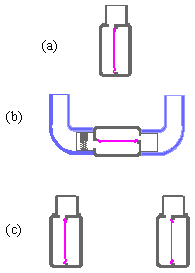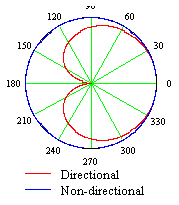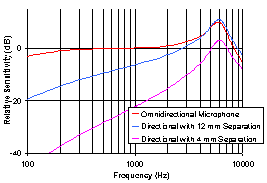Much has been written recently on the advantages to the hearing aid user of an aid having a directional microphone response: A directional aid can make it easier for the user to hear in noisy environments. The reason is that the directional aid has reduced sensitivity to sounds arriving from directions behind the user compared to its sensitivity to sounds arriving from the front. If users adopt the standard listening strategy of looking at the person they wish to hear, then they will hear the person's voice with full sensitivity while a part of the environmental noise coming from behind will be reduced.
This is a significant benefit and contributes significantly to user satisfaction with their aid (Kochkin 1996). In practice, directional aids can provide 4-5 dB improvement in Signal-to-Noise Ratio in noisy environments when the noise arrives equally from all directions. Furthermore, in theory, greater improvement is possible when the noise arrives predominantly from a direction in which the directional pattern has a null. Some manufacturers provide manual or automatic switching among a family of directional responses that may provide this further improvement in some nonuniform noise fields.
However directional microphone patterns in hearing aids also have two disadvantages that may be significant in other environments:
A hearing aid that has only a directional pattern presents these disadvantages to the user. Luckily, most modern directional hearing aids eliminate these problems for the user by providing a non-directional microphone pattern as well as the directional pattern. These aids have either a manual or an automatic switching method between the non-directional and directional patterns depending on the environment.
Before we examine the reasons for the two behaviors described above, let us review the operation of conventional microphones and directional microphones.
Basic Operation of Microphones
Figure 1

Figure 1 -(a) Non-directional microphone, (b) directional microphone, (c) Matched pair of non-directional microphones whose output can be processed to provide a directional pattern.
A caricature of the standard non-directional microphone is shown in Figure 1(a). The body of the microphone is a box that is divided into two chambers by the flexible diaphragm in the middle. Sound enters through the small tube at the top of the diagram and travels to the chamber on one side of the diaphragm. This chamber is called the 'front volume.' The acoustic pressure in the front volume causes the diaphragm to vibrate a very small amount. The chamber on the other side of the diaphragm, called the 'back volume' is closed to the outside environment. Not shown in the figure is an electrically charged plate in the back volume very near to the diaphragm. The diaphragm motion near the charged plate induces a small electrical voltage on the diaphragm that is amplified to be the output signal of the microphone.
Figure 1(b) is a directional microphone. The structure is basically the same as in (a) except that an opening has been made into the back volume for another sound entry port. The unit has two sound ports that sample the sound pressure at locations separated by a small distance. Now the sound pressure travels to both sides of the diaphragm. The diaphragm motion is driven by the difference in pressure on its two sides. If the acoustic pressure at the two ports is the same, as it is for a sound approaching the microphone from the direction away form the page, then there is zero pressure difference on the two sides of the diaphragm, and the microphone has no output. However as the acoustic wave propagates, for example, from right to left in the Figure, there will be a time delay in the acoustic signal at the two ports. Because of this time delay, the signals are not identical, and there is a small difference in pressure on the two sides of the diaphragm. This two-port directional microphone then has an output signal that depends on the direction of the arriving sound.
In most cases, the directional microphone has a small resistive screen placed in the rear sound entry tube. The addition of this screen provides an additional time delay in the acoustic signal moving to the back volume. This allows the directional response to be adjusted to suit the specific situation. The range of patterns available has been discussed elsewhere.
An alternative way of achieving directionality in a hearing aid is shown in Figure 1(c). Here, two non-directional microphones are included in the hearing aid. The microphone outputs are combined in the hearing aid circuitry to form a directional pattern. The range of possible directivities for this dual microphone system is the same as that available from the two-port directional microphone. In fact, the two methods of obtaining a directional pattern have so many properties in common, that the balance of this article will use the term 'directional pattern' to describe the behavior of both methods. The small differences in performance between the dual microphones and the directional microphone are discussed elsewhere (Thompson 1999), and will not be important in here.
Directional Microphones have more Noise than Non-directional Microphones
It seems a contradiction to say that:
a) Directional patterns are better for hearing in noise than non-directional microphones; and
b) Directional patterns are noisier than non-directional patterns.
In fact both statements are true. The confusion comes because the two statements are describing performance in different kinds of noise. In the first case, a directional microphone provides improved Signal-to-Noise ratio when the dominant noise source is from the environment. As seen in Figure 2, the directive microphone pattern senses the signal at full sensitivity, but senses a part of the noise with reduced sensitivity.
Figure 2

Figure 2 - The directional pattern senses the noise from behind the user with reduced sen-sitivity.
Figure 3

Figure 3 - The low frequency sensitivity of direc-tional patterns is much lower than that of the equivalent non-directional microphone
In the second case above, the noise refers to the internal noise from the microphone. This noise is unaffected by the directional pattern of the microphone. The reason for the higher internal noise in the directive pattern can be understood from the data in Figure 3. Notice that at low frequencies, the sensitivity of the directional pattern falls of rapidly. In order for a hearing aid with a directional pattern to have the same acoustic response as one with a non-directional pattern, additional amplifier gain must be used at low frequencies. Unfortunately this will amplify not only the signal, but also the microphone internal noise.
Depending on the microphone port separation for the directional microphone, the required additional gain may be greater than 10 dB at frequencies below 1 kHz. For a non-directional microphone, the internal noise is normally low enough to be below the user's hearing threshold, or at least is low enough to be masked by low level sounds in the environment. However with the addition of 10-30 dB of gain below 1 kHz, the internal noise could become audible and objectionable to many users.
Wind Noise is higher in directional patterns
The particular wind noise we are talking about here is the noise that is heard by people caused by the wind rushing past their own heads. We do not mean the sound of trees being blown by the wind, nor do we mean the sounds heard inside a house caused by the wind blowing against the walls outside. Wind noise caused by turbulent airflow around the head is a clear nuisance for normal hearing as well as hearing impaired people. The hearing impaired are likely to be more affected by it because they often need a greater signal-to-noise ratio in order to understand speech signals, and because the presence of the aid in or near their ears may cause some increase in the wind turbulence.
Figure 4

Figure 4 - As wind blows past the head, turbu-lence forms on the downwind side. (From Dillon, Roe, and Katsch, 1999, see references)
Figure 4 shows a KEMAR head in the wind tunnel at the National Acoustics Laboratory in Sydney, Australia (Dillon 1999). The airflow comes from the right side of KEMAR, which is the left side of the photo. A line of smoke is added to the air to allow visualization of the flow pattern. The flow remains laminar until it passes the head, at which point it breaks into turbulence which carries the smoke particles in a broad region toward the head. Turbulence is present in the throughout this broad smoke-filled region. The turbulence is a source of noise that is very close to the head. The unaided listener hears this as a loud noise because the source is so close to the ear.
For a person wearing a hearing aid with a non-directional (single port) microphone, the situation is quite similar. The presence of the hearing aid will change the turbulent source to some degree by changing the shape over which the wind flows. Dillon found that a BTE aid senses the highest wind noise, probably because its microphone projects somewhat from the head and is closest to the turbulence. The relative ranking of the ITE, ITC and CIC aids changes with the angle of approach of the wind, because the shape of the turbulent region changes with wind angle. In general, the wind noise level for all types of aid do not differ by more than about 10 dB for a given wind speed and angle of wind approach.
In contrast, measurements made by Knowles in a similar facility show a much larger difference between a non-directional pattern and a directional pattern in an ITE aid under similar measurement conditions. The wind noise level in the directional pattern is higher than that in the non-directional pattern by 20 to 30 dB. The reason for this is related to the way that a directional microphone senses sounds that originate from nearby sources.
The microphone sensitivity curves shown in Figure 3 were calculated for a sound source in the far field of the microphones. For an object the size of a hearing aid, the 'far field' effectively means a distance greater than about one foot (30 cm). Any sound source that is less than a foot from the microphone will have a higher sensitivity. This effect is used to good effect in headset microphones often used by telephone operators, in which the microphone is mounted on a small stalk very near the wearer's mouth. This 'close-talking' headset microphone picks up the wearer's voice with very high sensitivity and rejects sounds from far distances because of the relatively lower sensitivity.
However, for a hearing aid in wind with a directional microphone, the situation is exactly backwards. The interfering wind noise that is generated very close to the microphone is sensed with high sensitivity while the desired sound from the far field is sensed with low sensitivity. Whenever there is a choice, the directional microphone on a hearing aid should not be used when wind noise is present.
The solution: Selectable Directivity and Counseling for the User
To summarize the situation for directional patterns, the user needs directivity in high noise environments. The directive patterns sense the signal with high sensitivity, and sense at least a part of the noise with lower sensitivity. However, there are disadvantages of directive patterns as well. The disadvantages are:
Luckily, the environment in which directive patterns are needed is not an environment where the disadvantages are noticeable. Most modern hearing aids with directive patterns also have a way to switch from the directive patterns to a conventional microphone pattern when needed. The user never needs to deal with the disadvantages so long as
1. the hearing aid has the ability to switch to a non-directive pattern when needed, and
2. the switching takes place reliably.
For aids with a user-operated manual or remote control switch, the user must be instructed on the proper use of the switch. For many users, this is the optimum approach, because they are willing and able to operate the switch, and they prefer to be in control of their situation. Other users would do better with, or would simply prefer an automatic switching arrangement which does not require them to take any action when their environment changes. Both types of switching are available in the directional hearing aids available from manufacturers.
A part of the job of fitting an aid with selectable directivity must be to determine the personality and desires of the client, in order to recommend the proper style of directivity switching. Furthermore, when clients choose to operate the switch, they must be provided with enough information and counseling to be sure they consistently get the right configuration for the right environment.
This discussion which has concentrated on the disadvantages of the directional hearing aid patterns is not meant to dissuade anyone from recommending or using directional aids. The directional pattern remains a very good way to improve hearing in situations where environmental noise is a significant problem for the user. The discussion is meant to describe the reasons why the directional patterns are not the entire solution for all environments, and to provide the rationale for counseling clients on what to expect from their directional aids and when to use and not to use the directional pattern. In this way, you can be assured that your clients are getting the best performance in all environments.
References
Beard, J., and Nepomuceno, H. (2000), Wind noise levels for an ITE hearing aid, an internal report of Knowles Electronics.
Dillon, H., Roe, I., Katsch, R. (1999), Wind noise in hearing aids, presented at the Australian Hearing Conference, National Acoustics Laboratories, Sydney Australia, Nov. 1999. A paper based on this work has been submitted to JASA.
Kochkin, S. (1996), Consumer satisfaction & subjective benefit with high performance hearing aids, The Hearing Review 3(12) pp. 16-26.
May, Anne (1999), Case study on a child's use of multi-mic & FM technology, The Hearing Review 6(4) pp 36-38,47.
Mueller, H. Gustav and Ricketts, Todd A. (2000), Directional-microphone hearing aids: An Update, The Hearing Journal, 53(5) pp10-19.
Schuchman, G., Valente, M., Beck, L. B., and Potts, L. (1999), User satisfaction with an ITE directional hearing instrument, The Hearing Review 6(7) pp. 12-22.
Thompson, S. C. (1999), Dual microphones or directional-plus-omni: which is best?, High Performance Hearing Solutions Vol. 3, Supplement to The Hearing Review, Jan. 1999, pp. 31-35.
Venema, T.(1999), Three ways to fight noise: directional mics, DSP algorithms, and expansion, The Hearing Journal 52(10) pp. 58-62
Contact Address:
Stephen C. Thompson
Knowles Electronics, LLC
1151 Maplewood Drive
Itasca, Illinois 60143

